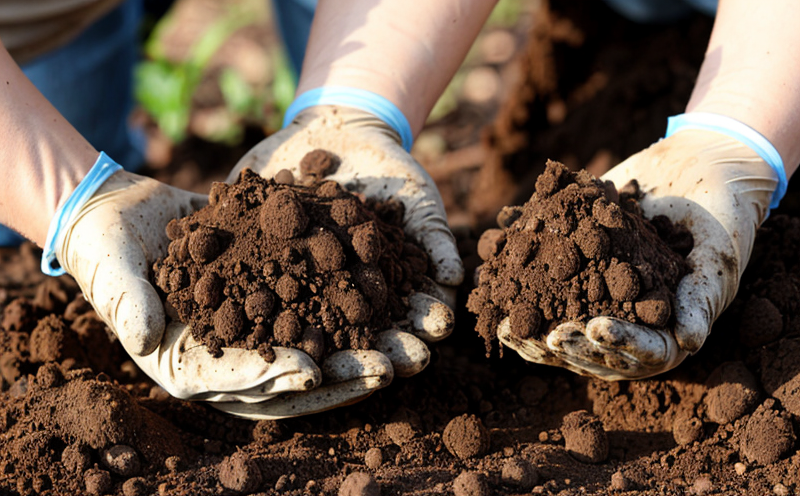ISO 17622 Soil Catalase Activity Testing
The ISO 17622:2013 standard is a crucial method in soil microbiology and biological testing. This protocol measures the catalase activity of microorganisms present in soil samples, which plays a vital role in breaking down hydrogen peroxide to water and oxygen. Catalase is an enzyme that can be found in various soil bacteria, fungi, and other organisms. Understanding its presence helps in assessing the health and diversity of microbial communities within the soil.
This testing method is particularly important for environmental science, agriculture, and waste management sectors where the quality and biodiversity of soil are key factors. By employing this standard, laboratories can provide reliable data on catalase activity to ensure compliance with regulatory standards and support research initiatives aimed at enhancing soil health.
The process involves several steps: first, a representative sample must be collected from the site under scrutiny using appropriate sampling techniques. The collected material is then prepared according to ISO 17622 guidelines, ensuring accurate representation of the microbial community in question. Once ready, the sample undergoes incubation with hydrogen peroxide; any catalase present will decompose this substance into oxygen and water.
For more precise measurement, spectrophotometric analysis is performed, comparing absorbance readings before and after treatment with hydrogen peroxide. The difference indicates the level of catalase activity within the sample. This approach allows for accurate quantification across different environments or conditions.
The significance of this test extends beyond mere compliance; it also aids in identifying potential sources of contamination or areas where intervention might improve overall soil health. For instance, increased levels could suggest higher microbial activity beneficial to decomposition processes while reduced activities may indicate stress factors affecting the ecosystem.
Understanding catalase activity provides insights into how efficiently soils process nutrients and resist adverse conditions like pollutants or extremes in temperature or pH. This information supports informed decisions regarding sustainable practices such as optimizing crop yields, managing waste disposal sites effectively, or restoring degraded lands.
| Key Steps | Description |
|---|---|
| Catalyst Preparation | Mixing the soil sample with a buffer solution containing hydrogen peroxide at specific concentrations. |
| Incubation Period | The mixture is incubated for an optimal time frame to allow sufficient catalase activity. |
| Spectrophotometric Analysis | Determining the absorbance changes post-incubation, which directly correlates with catalase levels. |
Scope and Methodology
The ISO 17622:2013 standard outlines a procedure for determining catalase activity in soil samples. This method applies to various types of soils including agricultural, forest, urban, and industrial sites where understanding microbial health is essential.
| Sample Preparation | Description |
|---|---|
| Preliminary Mixing | Mixing the fresh or air-dried soil sample with a buffer solution containing hydrogen peroxide. |
| Incubation Time | The mixture should be incubated for at least 30 minutes under controlled temperature conditions. |
| Measurement Techniques | Description |
| Spectrophotometry | Using a spectrophotometer to measure changes in absorbance, reflecting catalase activity levels. |
The incubation period allows time for the catalase enzyme to act on hydrogen peroxide. During this phase, if there is significant catalase activity present in the soil, it will decompose the hydrogen peroxide into water and oxygen, resulting in a measurable change in absorbance when analyzed spectrophotometrically.
The standard specifies detailed procedures for preparing solutions, calibrating equipment, and interpreting results. Compliance with these procedures ensures accurate measurements that reflect true catalase activity within soil samples.
Customer Impact and Satisfaction
Implementing ISO 17622 Soil Catalase Activity Testing has numerous benefits for our clients across different industries:
- Agricultural Sector: Helps in optimizing fertilization practices by understanding the breakdown capabilities of soil microbes.
- Environmental Monitoring: Supports regulatory compliance and ecosystem health assessments through reliable data on microbial activity.
- R&D Engineers: Provides valuable insights into the effects of new treatments or amendments on soil microflora.
- Procurement Teams: Ensures that purchased materials meet specified quality standards related to catalase content and potential impact on soil health.
Client satisfaction is paramount, and our commitment ensures accurate results every time. We pride ourselves on delivering services that exceed expectations by offering comprehensive support from sample collection through final analysis report generation.
Environmental and Sustainability Contributions
The pursuit of sustainable practices includes minimizing environmental impact while enhancing resource efficiency. ISO 17622 Soil Catalase Activity Testing contributes significantly to both goals:
- Resource Efficiency: By accurately measuring catalase activity, we help clients make informed decisions about resource usage, ensuring optimal use without waste.
- Ecosystem Health: Understanding catalase levels aids in preserving soil biodiversity and supporting natural processes like nutrient cycling and pollution degradation.
Our testing methods support sustainable agriculture by promoting healthy soils which are crucial for long-term productivity. In industrial settings, this knowledge helps mitigate risks associated with contamination or poor environmental practices.





